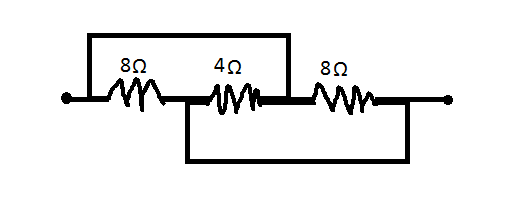Calculate the equivalent resistance in this circuit ...
 According to the image ,
What is the equivalent resistance ?
According to the image ,
What is the equivalent resistance ?
This section requires Javascript.
You are seeing this because something didn't load right. We suggest you, (a) try
refreshing the page, (b) enabling javascript if it is disabled on your browser and,
finally, (c)
loading the
non-javascript version of this page
. We're sorry about the hassle.
5 solutions
they are in series R1 + R2 + R3 = Req ?????
They aren't in parallel... The shortening logic is incorrect... Study the picture carefully
Log in to reply
yes they are parallel
Log in to reply
Can you tell us that how they are parallel ?
Log in to reply
@Taha Ali – Becz 3ragistance are attached with both terminal
No calculations required. As they are in parallel first 8 in parallel with 8 gives equivalent resistance 4 which again in parallel with 4 gives 2 as final answer.
The current in the circuit will follow the non-resistance path above the 8 and 4 ohm resistor and will only encounter the last 8 ohm resistor . So the equivalent resistance will be 8 ohm
rishab is right, if current flows to the circuit, the current prefer to flow in non-resistive line. so, the Req is 8 ohms
here by rearranging the network ,3 resistors are in parallel so by using formula we can solve
i think the answer is wrong these are not in parallel but htere is another way to solve this
Log in to reply
what is your another way to solve this ?
Log in to reply
Current tends to follow the path of slightest resistance. So, whichever point be the input point of the current, it'll take the short circuit path & reach the final resistor. so the resistance it would face is 8 ohm. That's what I can see, please point out, if I'm wrong.
Log in to reply
@Sameen Tz – That's what I was seeing, to me too 8 appears to be the answer as the current will take the path of least resistance and in both the first and third junction easy paths are available...
short circuit route way, only 8ohm is active, i think
i will tell you
Yes, they ain't in parallel!
These are in parellal
Log in to reply
get lost in the woods
abey 6 question solve kiya hain and i have solved 401
All are in parallel
With the 4 ohm removed, the 8 ohms are just in parallel as 4 ohms. Any added connection must make a smaller resistance; further, the 4 ohm resistor crossing the parallel is in parallel with the resultant 4 ohm again. As a result, two 4 ohms in parallel make 2 ohms as a whole. No complicated situation involved.
No Current will go through the 4. End up with 2 8's in parallel and so answer is 4
Name the junctions A, B, C and D Now you can note that as the junction A and C is shorted they are one and the same Similarly the junctions B and D will be one and the same as they are shorted
Now redraw the diagram considering only the junctions A and B
You can notice that the resultant diagram will be in the form of three resistors in a parallel circuit
Then effective resistance of resistors in Parallel is given by 1/Rs=1/R1 + 1/R2 + 1/R3
On solving using R1=8ohm R2=4ohm and R3=8ohm The value of Rs will be 2ohm